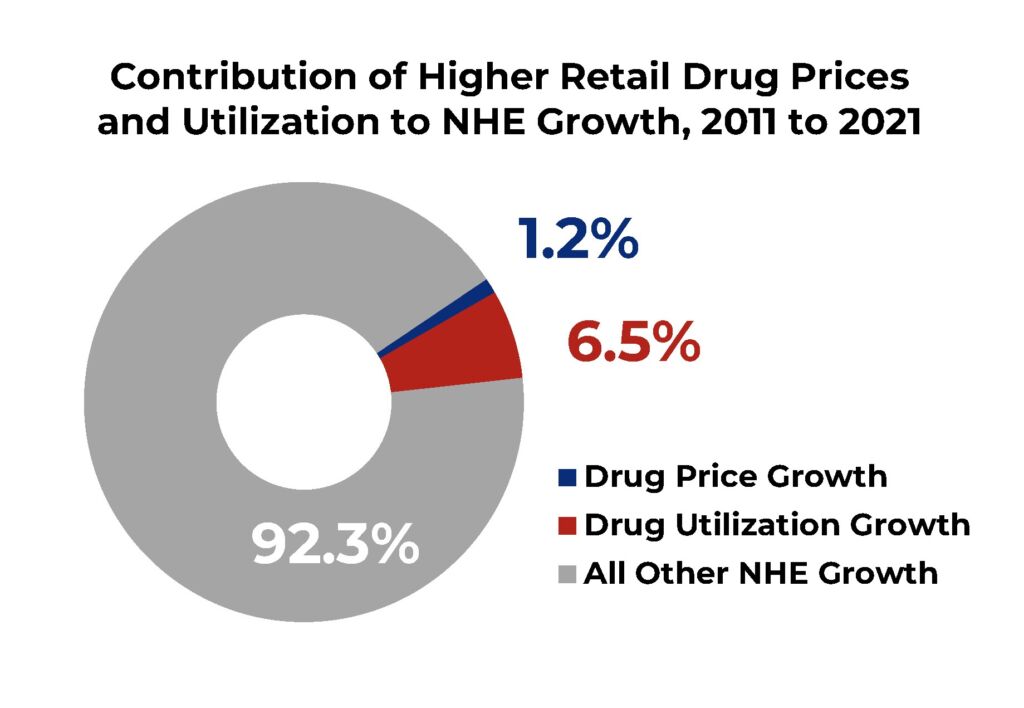Drug prices dropped for fourth consecutive year according to federal data
Declining drug prices show Inflation Reduction Act’s focus on drug price controls missed the mark
Not long after the President Biden signed the Inflation Reduction Act, the Department of Health and Human Services (HHS) released two new reports to illustrate the positive impact of the new law on prescription drug prices. The HHS press release highlighted how the reports “illustrate the urgency of addressing skyrocketing prescription drug costs in America” (emphasis added).
“Skyrocketing” is an interesting word choice coming from HHS when the national health expenditure (NHE) data HHS reports each year shows drug prices are declining. Last week HHS released the latest NHE data which shows drug prices declined in 2021 for the fourth consecutive year.
As I explained in an earlier article, the two HHS reports produced by the Office of the Assistant Secretary for Planning and Evaluation (ASPE) misreported their own data and failed to put the data in context.
NHE data offers a much more reliable view on drug pricing than the other two ASPE reports. The Centers for Medicare & Medicaid Services Office of the Actuary (OACT) in HHS is responsible for the NHE data. By law, OACT operates “in accordance with professional standards of actuarial independence.” Thus, unlike ASPE and other offices in HHS, OACT operates with a certain level independence from the political leadership.
In July, American Experiment published the report “Pharmaceutical Price Controls: Impact of Drug Pricing Legislation on Access to Life-Enhancing Drugs” which reviewed the likely impacts of the policies that were eventually passed in the Inflation Reduction Act. That report used NHE data to show how retail drug price increases contributed only a small portion to the overall increase in health care costs from 2010 to 2020.
NHE data provide a price index that measures and isolates the change in annual retail drug prices. Using that price index allows a rough calculation of the contribution that price changes contribution higher care costs versus utilization. From 2010 to 2020, higher drug prices accounted for just 2.4 percent of the overall growth in health care costs. Higher drug utilization made up another 3.8 percent of this overall growth.
In 2021, the NHE drug price index dropped for the fourth consecutive year by another 1.0 percent. At the same time, prices went up across every other health care category with the exception of durable medical equipment and other non-durable medical products. As result, a look at the most recent ten-year period from 2011 to 2021 shows drug prices account for an even smaller portion of the overall increase in NHE.
The chart below shows higher drug prices contributed just 1.2 percent to the overall growth in NHE from 2011 to 2021. Drug utilization, however, increased substantially in 2021 and increased to 6.5 percent of the overall growth in NHE over this ten-year period. COVID vaccines, treatments, and an uptick in doctor visits likely contributed to this higher drug utilization.

After four consecutive years of declining drug prices, a look at the last five years shows retail drug prices pulled the overall growth in NHE down by $9 billion. By contrast, higher hospital prices increased NHE by $143 billion.
Despite a clear downward trend, declining drug prices do not fit the current White House narrative. Unfortunately, they appear to be free to falsely decry “skyrocketing” drug prices without any scrutiny from the media.
As someone who worked at HHS in the previous administration, I can attest to the intense media scrutiny all our data and assertions received. Therefore, we knew we had to be spot-on every time. That’s the way it should be.
Unfortunately, these days the media applies a lesser standard to the Biden administration’s data and assertions. So, in this case, the public hears about evil price-gouging drug companies and never knows that it’s really their neighborhood (and often non-profit) hospital that’s fleecing them.
In this environment, no one should be surprised that this country has yet to make a dent in the high and rising cost of health care.